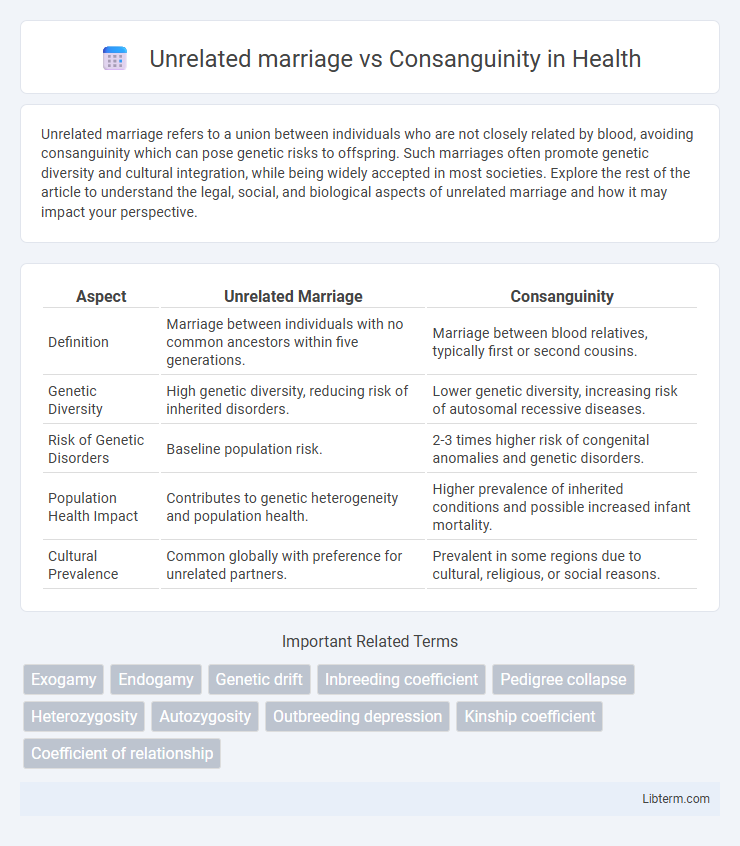Unrelated marriage refers to a union between individuals who are not closely related by blood, avoiding consanguinity which can pose genetic risks to offspring. Such marriages often promote genetic diversity and cultural integration, while being widely accepted in most societies. Explore the rest of the article to understand the legal, social, and biological aspects of unrelated marriage and how it may impact your perspective.
Table of Comparison
| Aspect | Unrelated Marriage | Consanguinity |
|---|---|---|
| Definition | Marriage between individuals with no common ancestors within five generations. | Marriage between blood relatives, typically first or second cousins. |
| Genetic Diversity | High genetic diversity, reducing risk of inherited disorders. | Lower genetic diversity, increasing risk of autosomal recessive diseases. |
| Risk of Genetic Disorders | Baseline population risk. | 2-3 times higher risk of congenital anomalies and genetic disorders. |
| Population Health Impact | Contributes to genetic heterogeneity and population health. | Higher prevalence of inherited conditions and possible increased infant mortality. |
| Cultural Prevalence | Common globally with preference for unrelated partners. | Prevalent in some regions due to cultural, religious, or social reasons. |
Introduction to Unrelated Marriage and Consanguinity
Unrelated marriage refers to unions between individuals with no close biological ties, promoting genetic diversity and reducing the risk of hereditary diseases. Consanguinity involves marriage between blood relatives, often first or second cousins, which can increase the probability of inherited genetic disorders due to shared genes. Understanding the genetic and social implications of unrelated marriage versus consanguineous unions is essential for public health and genetic counseling.
Definitions and Key Concepts
Unrelated marriage refers to the union between individuals who share no common ancestry or blood relations, emphasizing genetic diversity and reducing hereditary health risks. Consanguinity denotes marriage between closely related individuals, typically second cousins or closer, which increases the probability of inheriting recessive genetic disorders due to shared genes. Understanding these definitions highlights the key concepts of genetic relatedness and potential health implications in family planning and population genetics.
Historical and Cultural Perspectives
Unrelated marriage, often favored in many modern societies, contrasts sharply with consanguineous unions, which have historical roots in preserving family wealth and social ties in cultures across South Asia, the Middle East, and parts of Africa. Consanguinity, typically involving marriage between close relatives such as first cousins, has been culturally sanctioned to maintain lineage purity and reinforce tribal or clan solidarity. Historical records show varying acceptance of these practices, influenced by religious doctrines, legal systems, and socio-economic structures shaping marriage norms globally.
Prevalence Around the World
Unrelated marriage predominates in Western countries, reflecting cultural preferences for genetic diversity and social structures that discourage consanguinity. Consanguineous marriages remain highly prevalent in regions such as the Middle East, North Africa, and parts of South Asia, with rates exceeding 20-50% in countries like Pakistan, Saudi Arabia, and Iran. Global shifts show urbanization and education gradually reducing consanguineous unions, although they persist due to traditions and socio-economic factors in many communities.
Genetic Implications and Health Risks
Unrelated marriages typically present lower genetic risks compared to consanguineous unions, which involve closely related individuals sharing a higher proportion of genes. Consanguinity increases the probability of autosomal recessive disorders due to the inheritance of identical gene mutations from common ancestors. Genetic counseling is crucial in consanguineous marriages to assess risks of congenital anomalies, inherited metabolic disorders, and potential long-term health complications in offspring.
Social and Psychological Effects
Unrelated marriage often promotes genetic diversity, fostering broader social networks and reducing risks of hereditary disorders, which can enhance psychological well-being by lessening familial stress. Consanguineous unions, common in certain cultures, may strengthen familial bonds and social cohesion but increase the likelihood of genetic diseases, potentially leading to heightened anxiety and social stigma. Understanding these dynamics is crucial for public health strategies aimed at supporting mental health and social integration in diverse populations.
Legal and Religious Considerations
Unrelated marriage, typically involving partners with no common ancestry, is legally unrestricted in most jurisdictions, while consanguineous marriage--between close blood relatives--is often subject to legal limitations due to concerns about genetic risks and inheritance laws. Religiously, consanguinity may be prohibited or discouraged in certain faiths, such as within Christianity and Islam, where degrees of kinship influence marital permissibility, whereas unrelated marriages generally face fewer doctrinal barriers. Legal frameworks and religious doctrines together shape societal norms by balancing genetic health considerations and moral teachings regarding family unions.
Impact on Offspring and Family Structure
Unrelated marriages generally result in greater genetic diversity, reducing the risk of inherited disorders and promoting healthier offspring, while consanguineous unions increase the probability of recessive genetic conditions due to shared ancestry. The family structure in consanguineous marriages often exhibits stronger kinship bonds and tighter familial networks, which can influence social support systems and inheritance patterns. In contrast, unrelated marriages typically encourage broader social integration and genetic variation, impacting both individual health outcomes and community dynamics.
Public Health Policies and Recommendations
Public health policies emphasize genetic counseling and screening programs to address risks associated with consanguineous marriages, which increase the prevalence of autosomal recessive disorders. In contrast, unrelated marriages generally exhibit lower genetic risks, reducing the burden on healthcare systems. Recommendations encourage awareness campaigns and premarital testing in high-consanguinity regions to mitigate congenital anomalies and improve population health outcomes.
Future Trends and Research Directions
Future trends in unrelated marriage research emphasize increased genetic diversity and reduced risk of hereditary disorders compared to consanguineous unions. Advances in genomic technologies enable more precise identification of genetic risks associated with consanguinity, promoting personalized counseling and intervention strategies. Emerging studies focus on the sociocultural impacts and long-term health outcomes of both marriage types to guide public health policies worldwide.
Unrelated marriage Infographic

 libterm.com
libterm.com